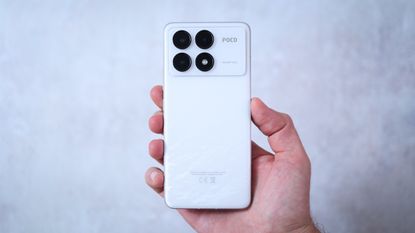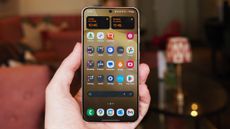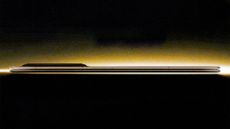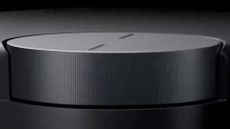Xiaomi's Poco sub-brand is a dab hand at squeezing great specs into a budget body – but the Poco F6 Pro is the first in the line that doesn't feel budget. Made of glass and metal, it marries premium design with a fantastic-looking screen and packs flagship performance too.
Poco does make a few cuts to cram in all that power, though, meaning the F6 Pro's secondary cameras are weak. The phone also misses out on wireless charging, while Xiaomi's HyperOS software – an already busy take on Android – presents a whole bunch of pre-installed bloatware.
Despite such shortcomings, however, the Poco F6 Pro is still a spec champion for the price. But the best cheap phones are more competitive than ever around this price point. So is the Poco F6 Pro's good enough to clinch victory over the excellent Google Pixel 8a?
Poco F6 Pro: price & availability
While the F6 Pro is expensive for a Poco phone, costing £499 (roughly $630/AU$940) for the 12GB RAM/256GB storage option (or £599 (roughly $760/AU$1,130) for the 16GB RAM/1TB storage option), it certainly crams in plenty of space for your apps, games, and files – that's at minimum double the storage compared to the entry Pixel 8a.
The Poco F6 Pro is available to buy now online and at physical Xiaomi stores. Typically, Poco is Xiaomi's online-only brand, so you won't find Poco phones ranged by networks or carriers, making them a great pairing for fans of SIM-only contracts.
Poco F6 Pro review: design & display

With a flat screen, flat sides, and curved corners, the Poco F6 Pro shares the same smartphone-by-numbers DNA as the Samsung Galaxy S24 and iPhone 15. And that's no bad thing: it's easy to grip and feels well-weighted; the corners sit comfortably against a palm, and the slight curve to its back adds an almost Nothing Phone (2) softness in the hand.
Available in black or white, the back panel has a shimmer to it that looks better on the white version in my view. The matte metal frame is colour-matched to the back panel colour, and a raised glass camera bump adds an extra flourish around the back of the phone.
The Poco F6 Pro's right side houses power and volume buttons. At the base is a USB-C port and a dual-SIM slot, and there's an IR blaster at the top so the phone can double as a TV remote control.
In the Poco F6 Pro's box, you get a charging brick and an opaque black case, and the phone also has a pre-fitted screen protector. Matched with IP54 splash resistance, the F6 Pro is relatively well protected, though the hardier IP67 Pixel 8a can be fully submerged.
From the front, the F6 Pro's 6.67-inch AMOLED screen impresses with slimline bezels and a vibrant, bright picture. Likely the sharpest screen on any midrange smartphone, its 2K resolution (1440 x 3200 pixels, meaning 526ppi pixel density) makes it even sharper than an iPhone 15 Pro Max or a Samsung Galaxy S24 Ultra.
The F6 Pro's screen is excellent for watching content. While some phones like the Redmagic 9 Pro miss out on Netflix HD or HDR certification, the F6 Pro doesn't, so streaming video takes advantage of the display's HDR10+ credential and peak HDR brightness of 4000 nits.
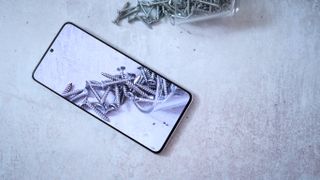
When it comes to outdoor viewing, the F6 Pro climbs up to 1200 nits and is easy to see even on sunny days. The minimum brightness isn't quite as low as Samsung's flagships, but it still gets dim enough for comfortable low-light viewing without noticeable flicker.
The screen is smooth with a 120Hz refresh rate. It can be set to either 60Hz or 120Hz in the settings or left to its own devices, switching refresh rate based on what's on the screen.
With stereo speakers, the Poco F6 Pro's sound is loud and clean for the price. When it comes to depth and bass, it misses out when compared to pricier flagships from Apple but goes toe-to-toe with the best from Samsung and the Pixel 8a.
Poco F6 Pro review: performance & battery life
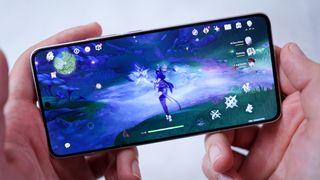
Powered by a 2023 flagship chipset, the Qualcomm Snapdragon 8 Gen 2, gamers will appreciate the Poco F6 Pro's value in terms of performance. The 8 Gen 2 is still a top-tier chip that can run games like Genshin Impact at maxed-out graphics settings, so the F6 Pro is one of the best value-for-money gaming phones you can buy.
With its metal frame and relatively slim body, the F6 Pro doesn't dissipate heat like a dedicated gaming phone with a fan, so it does heat up after 20-minute gaming sessions. It doesn't quite get unusably hot, but it can start to feel uncomfortable, though dialling back the graphics settings or turning off performance mode helps.
Available in two RAM and storage options in the UK – 256GB/12GB or 1TB/16GB – Poco also loads the phone up with plenty of space for files and games. While there's no SD card expansion, the F6 Pro should comfortably last a couple of years at its base capacity unless you have a huge offline file library.

Running Android 14 out of the box, Poco commits to three years of software updates and four years of security updates. In its price group, this still doesn’t compete with the seven-year software update promise Google offers with the Pixel 8a.
To counter that point, though, the Poco F6 Pro's hardware is more future-proofed. Specifically, the Tensor G3 chip in the Pixel 8a is less powerful, and the phone's UFS 3.1 storage is also slower than the F6 Pro's UFS 4.0 storage. As mentioned, it also packs a lot more storage.
While it runs Android, Poco's interface experience is heavily customised. The F6 Pro is loaded up with a lot of bloat – games and apps that you can uninstall – and Xiaomi's HyperOS is also occasionally overbearing. While at the Xiaomi 14 Ultra's price, this is a tough pill to swallow, given the F6 Pro's value for money, occasional UI grumbles are much easier to make peace with.

Poco bundles in a 120W fast-charger with the F6 Pro, powering it up in around 20-minutes which is incredibly quick – especially at the phone's price. So while it misses out on the Google 8a's wireless charging, fans of fast-charging might prefer Poco's solution.
The F6 Pro's battery lasts a full day with regular use, though it won't give you a second day, unlike similarly priced phones like the OnePlus 12R and Redmagic 9 Pro.
Poco F6 Pro review: cameras
The Poco F6 Pro's cameras arguably explain its relatively low price given its power and premium styling. The primary 50-megapixel camera is a quality sensor with its respectably large 1/1.55in size and wide f/1.6 aperture, but the 8MP ultra-wide and 2MP macro cameras are significantly weaker.
Photos from the primary camera typically look good across lighting conditions. Colours are lively and saturated without looking totally overkill (as seen on past Poco phones) and detail is rich.
In bright environments, the F6 Pro's lens flares more than most, and the phone does tend to brighten up scenes and flatten facial detail, so it isn't my favourite portrait camera phone at its price – the Honor 200 does a better job for faces.
The F6 Pro isn't afraid of contrast, though still pulls out pleasing detail from shadows. With its wide f/1.6 lens, it can also create a pleasingly soft-focus background when taking photos of nearby objects.
The 8MP ultra-wide camera misses out on autofocus and lacks the clarity of the main camera, though in bright environments it's actually impressive, pulling out balanced photos that pack good dynamic range given the camera's spec.
Poco's processing has improved for 2024, so the F6 Pro ekes more out of its mediocre 8MP ultra-wide than the F5 Pro did. Even the F6 Pro's zoom impresses in bright scenes up to around 3x, with no visible detail fall-off until you pinch into the picture.
Where the ultra-wide and zoom performance fall apart is in dark environments when there isn't a steady hand holding the phone and a still subject in front of it.
The Poco F6 Pro's 16MP selfie camera isn't pin sharp, but it's typically flattering in most environments, though as with the main camera, it has a tendency to flatten faces.
While its video recording caps out at 1080p, the rear camera mix can record at up to 4K resolution, 60fps, and videos pack similar qualities to photos shot on the phone, being zingy and detailed, though struggling in low-light environments. Its nighttime video still beats the Google Pixel 8a and the stabilisation is also respectable, even at max resolution.
Poco F6 Pro review: verdict

For gamers on a budget, the Poco F6 Pro could be the best phone of 2024, out-performing the competition when it comes to power-to-price ratio.
Its stills camera can't best the Google Pixel 8a, though it does capture better low-light video – which is impressive.
With an excellent screen, ample storage, and premium build, the F6 Pro marks a brave new world for Poco, going beyond budget-feeling and taking on more premium midrange phones like the OnePlus 12R and Motorola Edge 50 Pro.
Also consider
The Poco F6 Pro's weak points are its secondary cameras, lack of wireless charging, Xiaomi's busy interface, and pre-loaded bloatware. The most obvious alternative choice is the Google Pixel 8a, though it also compromises on storage and performance, so it won't be a smart choice for gamers.
The Honor 200 packs a better camera than the F6 Pro and more storage than the Pixel 8a, though dials back gaming performance. Meanwhile, the OnePlus 12R offers a great balance in a slightly pricier package.
Alternatively, you could opt for the Poco F6 for similar performance in a plastic body with inferior cameras but some cost saving, or if you're not too worried about gaming, the Galaxy A55 packs a familiar Samsung interface, plus IP67 water-resistance, though weaker gaming performance.
